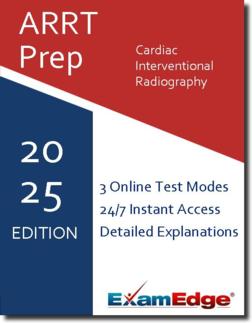ARRT® Cardiac-Interventional Radiography (CI) Practice Tests & Test Prep by Exam Edge - Topics
Based on 40 Reviews
- Real Exam Simulation: Timed questions and matching content build comfort for your ARRT Cardiac-Interventional Radiography test day.
- Instant, 24/7 Access: Web-based ARRT Cardiac-Interventional Radiography practice exams with no software needed.
- Clear Explanations: Step-by-step answers and explanations for your ARRT exam to strengthen understanding.
- Boosted Confidence: Reduces anxiety and improves test-taking skills to ace your ARRT Cardiac-Interventional Radiography (CI).

Understanding the exact breakdown of the ARRT Cardiac-Interventional Radiography test will help you know what to expect and how to most effectively prepare. The ARRT Cardiac-Interventional Radiography has 175 multiple-choice questions The exam will be broken down into the sections below:
| ARRT Cardiac-Interventional Radiography Exam Blueprint | ||
|---|---|---|
| Domain Name | % | Number of Questions |
| Equipment and Instrumentation | 21% | 37 |
| Patient Care | 24% | 42 |
| Cardiac-Interventional Procedures | 55% | 96 |


